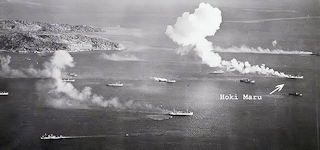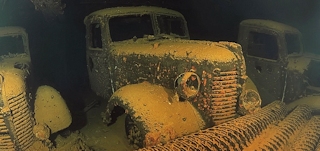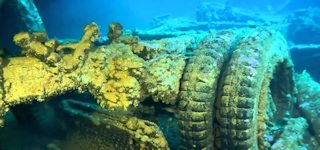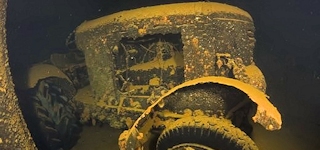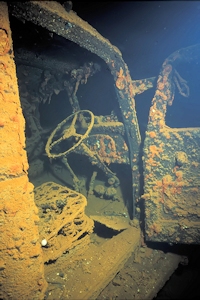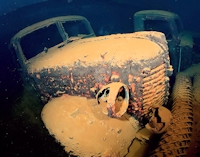Hoki Maru
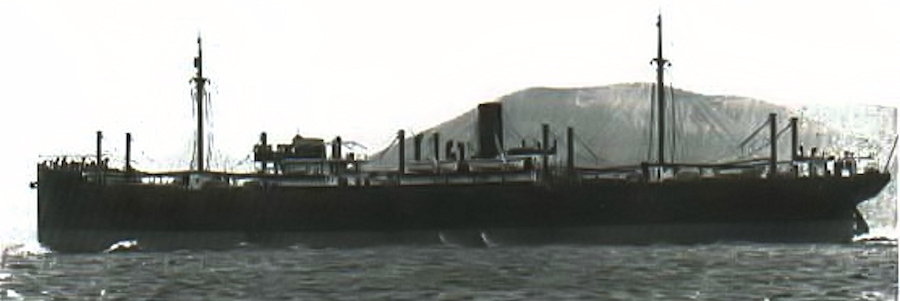
Originally built as the MV Hauraki, named after New Zealand’s Hauraki Gulf, she was launched on 28 November 1921. She displaced 7,113 tons gross, was 137.5 metres (450.3 feet) long, and measured just under 18 metres (58.2 feet) wide. The MV Hauraki was built for the Union Steam Ship Company of New Zealand Ltd and entered service on 13 May 1922, to ply the trans-Pacific cargo trade, mostly Sydney or Melbourne to Fiji.
On 4 July 1942 the MV Hauraki left Fremantle (Australia) bound for Colombo in Sri Lanka. She was on her way from New Zealand to the Middle East with a load of war supplies. On 12 July 1942 at about 2150, the MV Hauraki was ambushed by the armed merchant cruisers Hokoku Maru and Aikoku Maru and captured. She was taken to Singapore and the crew sent to Ofuna Camp. The Captain, A. W. Creese and 23 crew survived the war. It is ironic that the Aikoku Maru was the ship that captured her, as today the Aikoku Maru lies less than a kilometre away, totally cut in half.
On 31 December 1942 the MV Hauraki was renamed Hoki Maru and designated as a special transport. Prior to this, some modifications were made to the ship including adding a deck to the bridge and making certain repairs, including some of the "damage" done to the ship by the New Zealand crew on the trip to Singapore after being seized. In early January 1944 the ship left Yokohama for Chuuk carrying coal, defence materials and other supplies. The ship arrived in late January.
On the morning of 17 February 1944 the Hoki Maru was anchored to the east of Eten island in Chuuk Lagoon. She was attacked first by ESSEX TBFs (Strike 2B) and was damaged by bomb hits. The bombs hit the port side and the fuel oil, petrol and diesel she was carrying in drums ignited and set the front of the vessel alight. Photographs show her on fire amidships but not in any danger of sinking following this attack. Around mid-day, she was bombed by Grumman Avenger launched from USS Yorktown CV10 in the "Masthead Attack" and shortly thereafter was torpedoed by planes from the USS Bunker Hill CV17 and left on fire. The torpedoes hit the port side where the fuel oil, petrol and diesel she was carrying in drums ignited and set the front of the vessel alight. When last seen as the final strike of the day was completed, the ship was totally ablaze and smoking heavily. She sank before the next strike of the second day arrived over their targets.
Wreck Description
Although badly damaged in the forward sections, the aft No. 5 Hold contains items that can be found nowhere else on the wrecks of Chuuk; building equipment and trucks. There is an airport mule (tractor), and a row of trucks (about 3 ton in size) all stowed neatly together side by side at lower level. The wheels still rotate freely after 70 years submerged. Further unlike the San Francisco Maru and the Sankisan Maru the bodies of these trucks are still intact. Perhaps the most exciting find in the holds are two still intact John Deere bulldozers.
"they stole my F@*#!* tractors"
Unknown Diver
On our April 2003 trip we heard a great story about these bulldozers. Apparently an ex-engineer from John Deere Tractor Corp was diving aboard the Thorfinn and was returning from a dive on the Hoki Maru. As the dive boat was nearing the Thorfinn there was a lot of commotion and yelling coming from the boat. The crew, thinking there had been an accident scrambled to get the first aid equipment ready. As the boat got closer they could make out what the guy was saying - "they stole my F@*#!* tractors". Apparently, just prior to attack on Pearl Harbor, the MV Hauraki was carrying two of the world’s first hydraulic blade bulldozers. Partway into the journey, not long after Pearl Harbor’s attack, she broke down with first one and then two main engines failing. While standing still and with Japan now officially an Axis member at war, she was approached by the fully armed merchant cruisers 'Hokoku Maru' and ‘Aikoku Maru’. Afterwhich several shots were fired to gain a white flag of surrender. The MV Hauraki was commandeered by the Japanese, renamed the Hoki Maru, and the bulldozers were never seen again...until the day this engineer dived the Hoki Maru.
